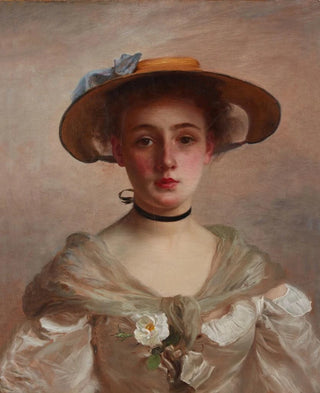Art print | Portrait of a young woman - Gustave Jean Jacquet


View from behind

Frame (optional)
Gustave Jean Jacquet's "Portrait of a Young Woman" is a masterpiece that evokes timeless beauty and the delicacy of the feminine soul. Created in the late 19th century, this artwork reflects an artistic context where the depiction of the female subject takes center stage. Jacquet, through his technical mastery and keen eye for detail, manages to capture not only the physical appearance of his model but also a deeper essence, a palpable emotion that transcends mere visual representation. The gaze of the young woman, both thoughtful and dreamy, invites the viewer to ponder her thoughts and desires, thus creating an intimate connection between the artwork and its observer.
Style and uniqueness of the work
Jacquet's style is characterized by a realistic approach, blended with an impressionist sensitivity that gives his portraits an almost dreamlike atmosphere. In "Portrait of a Young Woman," the chosen color palette is both soft and nuanced, highlighting the delicate shades of the skin and the subtle reflections of the hair. The interplay of light and shadow, skillfully orchestrated, adds an almost sculptural dimension to the female figure. Jacquet excels in rendering fabrics, making each drape appear alive, as if in motion. This ability to marry technique and emotion makes this work a perfect example of portrait art from his era. The composition, meanwhile, is carefully balanced, with a background that, although discreet, contributes to the overall harmony of the scene.
The artist and his influence
Gustave Jean Jacquet, born in 1846, was a French painter whose work is often associated with the academic movement. Although his style is rooted in the traditions of his time, Jacquet was able to diverge by incorporating elements of a more modern sensibility. His training at the École des Beaux-Arts in Paris allowed him to develop a rigorous technique, but it is his innate sense of observation that truly sets him apart. Jacquet influenced many contemporary artists and left a lasting mark on the French art scene. His portraits, often imbued

Matte finish

View from behind

Frame (optional)
Gustave Jean Jacquet's "Portrait of a Young Woman" is a masterpiece that evokes timeless beauty and the delicacy of the feminine soul. Created in the late 19th century, this artwork reflects an artistic context where the depiction of the female subject takes center stage. Jacquet, through his technical mastery and keen eye for detail, manages to capture not only the physical appearance of his model but also a deeper essence, a palpable emotion that transcends mere visual representation. The gaze of the young woman, both thoughtful and dreamy, invites the viewer to ponder her thoughts and desires, thus creating an intimate connection between the artwork and its observer.
Style and uniqueness of the work
Jacquet's style is characterized by a realistic approach, blended with an impressionist sensitivity that gives his portraits an almost dreamlike atmosphere. In "Portrait of a Young Woman," the chosen color palette is both soft and nuanced, highlighting the delicate shades of the skin and the subtle reflections of the hair. The interplay of light and shadow, skillfully orchestrated, adds an almost sculptural dimension to the female figure. Jacquet excels in rendering fabrics, making each drape appear alive, as if in motion. This ability to marry technique and emotion makes this work a perfect example of portrait art from his era. The composition, meanwhile, is carefully balanced, with a background that, although discreet, contributes to the overall harmony of the scene.
The artist and his influence
Gustave Jean Jacquet, born in 1846, was a French painter whose work is often associated with the academic movement. Although his style is rooted in the traditions of his time, Jacquet was able to diverge by incorporating elements of a more modern sensibility. His training at the École des Beaux-Arts in Paris allowed him to develop a rigorous technique, but it is his innate sense of observation that truly sets him apart. Jacquet influenced many contemporary artists and left a lasting mark on the French art scene. His portraits, often imbued






